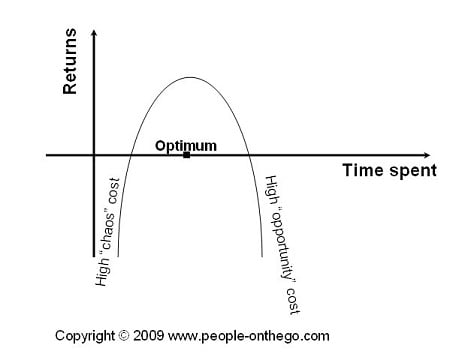 A couple of weeks ago, I made the transition from Vista to Windows 7, and reported on my initial positive experience with Windows 7. I also reflected on how technology can get in the way or be an enabler of productivity. Windows 7 falls in the enabler category.
A couple of weeks ago, I made the transition from Vista to Windows 7, and reported on my initial positive experience with Windows 7. I also reflected on how technology can get in the way or be an enabler of productivity. Windows 7 falls in the enabler category.
I am happy to report that my excitement about Windows 7 wasn’t just temporary. I believe that this switch is saving me substantial time, maybe an hour or more per day, and here are 3 ways in which this is taking place:
First: It is much faster. It loads faster and performs faster. This anxiety of having to reboot the computer right before or during teaching a class (for one reason or another) is gone. Restarting Windows 7 takes only a couple of minutes as opposed to my old Vista which took a lot longer (10 to 15 minutes). Not only it loads faster, it operates faster. The same machine seems to have gotten a new life injected in it with Windows 7.
Second: The ability of pinning and unpinning applications to the Taskbar, and pinning and unpinning documents to applications, makes is easy to keep the applications you use most and the documents you use most at your fingertips, and in the same place so they become familiar and you don’t have to do unnecessary thinking—let technology do this kind of thinking while we focus on the core stuff.
Third: The way you can quickly preview the currently open applications and documents is quite intuitive and makes switching between applications easy and intuitive. This is greatly appreciated in a Web 2.0 and 3.0 world where information is abundant and tasks are increasingly complex and dependent on many people and services.
Remember to reflect on your technologies and on whether they are helping or hindering your productivity (operating systems related, applications related, or hardware and accessories related), and consider making some optimizing and starting 2010 with a boost in productivity!







 Our tasks can take much more time than necessary. This tends to happen more so when we are dreading the task for one reason or another, our motivation is low, and we would rather be doing something else or not doing anything at all. We try to keep at it, and hope that miraculously we will get it done, and it keeps expanding and spiraling into this never-ending thing as our resistance grows and grows.
Our tasks can take much more time than necessary. This tends to happen more so when we are dreading the task for one reason or another, our motivation is low, and we would rather be doing something else or not doing anything at all. We try to keep at it, and hope that miraculously we will get it done, and it keeps expanding and spiraling into this never-ending thing as our resistance grows and grows. I needed to dive into this task that I reserved time for on my calendar which was to prepare for a Lotus Notes training session. I scheduled this on my calendar because it is important and I would like to get it done soon. To tell you the truth, lotus notes is not my favorite. I know my IBM friends may be a bit disappointed, but I think deep down, they know that too. So my mind came up with several interesting excuses, giving me great reasons and alibis for not doing what I know is the "right" thing for now.
I needed to dive into this task that I reserved time for on my calendar which was to prepare for a Lotus Notes training session. I scheduled this on my calendar because it is important and I would like to get it done soon. To tell you the truth, lotus notes is not my favorite. I know my IBM friends may be a bit disappointed, but I think deep down, they know that too. So my mind came up with several interesting excuses, giving me great reasons and alibis for not doing what I know is the "right" thing for now. Check-in with yourself right now, as you read this blog entry, what is it that you are avoiding or postponing? What is your "Lotus Notes". Finish what you're doing, and tackle this important task head it to head. Dedicate the next 40 minutes (not 30, but 40) to be fully focused on this task!
Check-in with yourself right now, as you read this blog entry, what is it that you are avoiding or postponing? What is your "Lotus Notes". Finish what you're doing, and tackle this important task head it to head. Dedicate the next 40 minutes (not 30, but 40) to be fully focused on this task! 
 In the past, it used to be e-mail and meetings that consumed everyone's time, and now it is e-mail, meetings, and social media, and not necessarily in this order. For years, in our workshops, we talked about the e-mail overload, and taught ways to overcome the e-mail overload, and now we are broadening the scope to include social media.
In the past, it used to be e-mail and meetings that consumed everyone's time, and now it is e-mail, meetings, and social media, and not necessarily in this order. For years, in our workshops, we talked about the e-mail overload, and taught ways to overcome the e-mail overload, and now we are broadening the scope to include social media. 
 Environmentally aware consumers are producing less waste by practicing the "3 Rs": Reduce. Reuse. Recycle. When it comes to productivity and accomplishments, we can use these same guidelines and reap some enormous benefits:
Environmentally aware consumers are producing less waste by practicing the "3 Rs": Reduce. Reuse. Recycle. When it comes to productivity and accomplishments, we can use these same guidelines and reap some enormous benefits: Something unique happens when we dive into and fully commit our energy to one task while letting everything else fade in the background. This forces us to go deeper and prompt us into moving the issues forward, into finding solutions, or even making breakthroughs. This is likely to unleash new levels of creativity, resourcefulness, and capabilities we may not even know we have.
Something unique happens when we dive into and fully commit our energy to one task while letting everything else fade in the background. This forces us to go deeper and prompt us into moving the issues forward, into finding solutions, or even making breakthroughs. This is likely to unleash new levels of creativity, resourcefulness, and capabilities we may not even know we have. You have this report to write, or presentation to prepare, or project plan to put into place. It is daunting. Too many parts to it. Too many issues to think about. You find yourself deferring it and feeling a little anxious when you think about it. It is just too big of an undertaking, and/or a sign of procrastination, and/or a sign of wanting it to be nothing less than perfect . You end up delaying it until there is no room for delaying any further. Then it becomes a high pressure situation. In addition, work quality suffers. If other urgent demands come up at the same time, and they will, then you've got one of these "situations" on hand.
You have this report to write, or presentation to prepare, or project plan to put into place. It is daunting. Too many parts to it. Too many issues to think about. You find yourself deferring it and feeling a little anxious when you think about it. It is just too big of an undertaking, and/or a sign of procrastination, and/or a sign of wanting it to be nothing less than perfect . You end up delaying it until there is no room for delaying any further. Then it becomes a high pressure situation. In addition, work quality suffers. If other urgent demands come up at the same time, and they will, then you've got one of these "situations" on hand.
